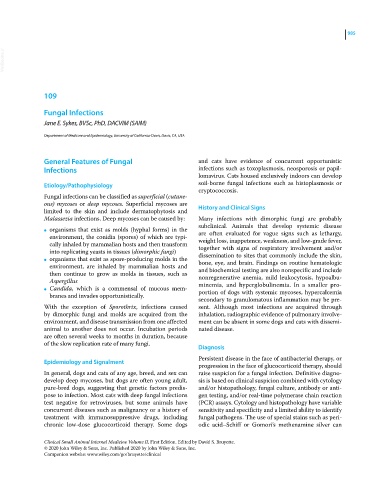Page 1047 - Clinical Small Animal Internal Medicine
P. 1047
985
VetBooks.ir
109
Fungal Infections
Jane E. Sykes, BVSc, PhD, DACVIM (SAIM)
Department of Medicine and Epidemiology, University of California‐Davis, Davis, CA, USA
General Features of Fungal and cats have evidence of concurrent opportunistic
Infections infections such as toxoplasmosis, neosporosis or papil
lomavirus. Cats housed exclusively indoors can develop
Etiology/Pathophysiology soil‐borne fungal infections such as histoplasmosis or
cryptococcosis.
Fungal infections can be classified as superficial (cutane
ous) mycoses or deep mycoses. Superficial mycoses are History and Clinical Signs
limited to the skin and include dermatophytosis and
Malassezia infections. Deep mycoses can be caused by: Many infections with dimorphic fungi are probably
subclinical. Animals that develop systemic disease
organisms that exist as molds (hyphal forms) in the
● are often evaluated for vague signs such as lethargy,
environment, the conidia (spores) of which are typi weight loss, inappetence, weakness, and low‐grade fever,
cally inhaled by mammalian hosts and then transform together with signs of respiratory involvement and/or
into replicating yeasts in tissues (dimorphic fungi)
organisms that exist as spore‐producing molds in the dissemination to sites that commonly include the skin,
● bone, eye, and brain. Findings on routine hematologic
environment, are inhaled by mammalian hosts and and biochemical testing are also nonspecific and include
then continue to grow as molds in tissues, such as nonregenerative anemia, mild leukocytosis, hypoalbu
Aspergillus
Candida, which is a commensal of mucous mem minemia, and hyperglobulinemia. In a smaller pro
● portion of dogs with systemic mycoses, hypercalcemia
branes and invades opportunistically.
secondary to granulomatous inflammation may be pre
With the exception of Sporothrix, infections caused sent. Although most infections are acquired through
by dimorphic fungi and molds are acquired from the inhalation, radiographic evidence of pulmonary involve
environment, and disease transmission from one affected ment can be absent in some dogs and cats with dissemi
animal to another does not occur. Incubation periods nated disease.
are often several weeks to months in duration, because
of the slow replication rate of many fungi.
Diagnosis
Persistent disease in the face of antibacterial therapy, or
Epidemiology and Signalment
progression in the face of glucocorticoid therapy, should
In general, dogs and cats of any age, breed, and sex can raise suspicion for a fungal infection. Definitive diagno
develop deep mycoses, but dogs are often young adult, sis is based on clinical suspicion combined with cytology
pure‐bred dogs, suggesting that genetic factors predis and/or histopathology, fungal culture, antibody or anti
pose to infection. Most cats with deep fungal infections gen testing, and/or real‐time polymerase chain reaction
test negative for retroviruses, but some animals have (PCR) assays. Cytology and histopathology have variable
concurrent diseases such as malignancy or a history of sensitivity and specificity and a limited ability to identify
treatment with immunosuppressive drugs, including fungal pathogens. The use of special stains such as peri
chronic low‐dose glucocorticoid therapy. Some dogs odic acid–Schiff or Gomori’s methenamine silver can
Clinical Small Animal Internal Medicine Volume II, First Edition. Edited by David S. Bruyette.
© 2020 John Wiley & Sons, Inc. Published 2020 by John Wiley & Sons, Inc.
Companion website: www.wiley.com/go/bruyette/clinical

